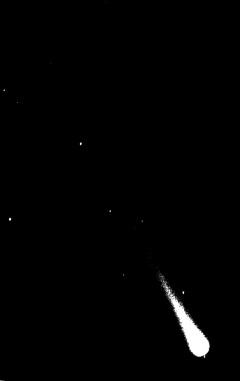Comet Ikeya-Seki: Comet Ikeya-Seki, as it appeard on November 1, 1965, ten days after perihelion passage. The observation was made with the 4-inch reflector of the U.S. Naval Obervatory. The attempt to obtain ultraviolet spectra of the comet was unsuccessful, primarily due to solar scattered light. For more information about the exposure, see Roemer, E. 1966, PASP, 78, 83R. For more information about the ultraviolet spectroscopy of Ikeya-Seki, see Feldman, P. D. 1979, LPICo, 361, 31F.
Credit: U.S. Naval Observatory / Astronomy Society of the Pacific / NASA Astrophysics Data System
It was only in my late twenties that I became interested in the possibilities of astronomy, and I made a direct transition out of typical physics into space astronomy. I just happened to stumble on it. I was an Assistant Professor here at Johns Hopkins University and I had experience in spectroscopy and optics, but no experience in the ultraviolet part of the spectrum. An associate here had already started working in the area of ultraviolet astronomy, and he was telling me that the field of ultraviolet measurements from space was really interesting. However, he was already an established senior scientist; I was still a young scientist trying for tenure, so I did not rush in to join him. However, I was sitting in my office one day when he strolled in leisurely, drew himself up to his full six foot, six inch height in front of me, looked down at me and asked, “Did you know that you are going to launch a rocket from Wallops Island in two weeks?” I gasped.
A NASA official had approached my senior colleague, Bill Fastie, about a newly discovered comet. He wondered if we could put together a rocket payload with a small telescope to see if we could spot it in the ultraviolet. The particular comet, Ikeya-Seki, created a target of opportunity, a term used to describe an event that occurs unexpectedly, lasts for a short window of time, and then is gone. Of course, we weren’t going to manufacture anything; we were just going to use spare parts for everything. Thus I underwent a crash course in sounding rocket astronomy, complete with walking around the rocket launch platforms at Wallops Island on the Virginia coast in the middle of the night. I really got hooked. I enjoyed doing that kind of thing, and I just got into the game.
Since we had an ongoing program of launching scientific rockets here, it was easy to do. Frankly, at that point the ultraviolet is where the action was. Infrared detectors were so awful back in the 60s and so primitive. People were making advances, but it was very hard. It’s only been in the recent decades that we’ve seen the advances in infrared astronomy that we saw in ultraviolet astronomy in the 1960s. That’s why infrared astronomy is very exciting right now. So I got into this game in a funny way, but I had a good time at it.


